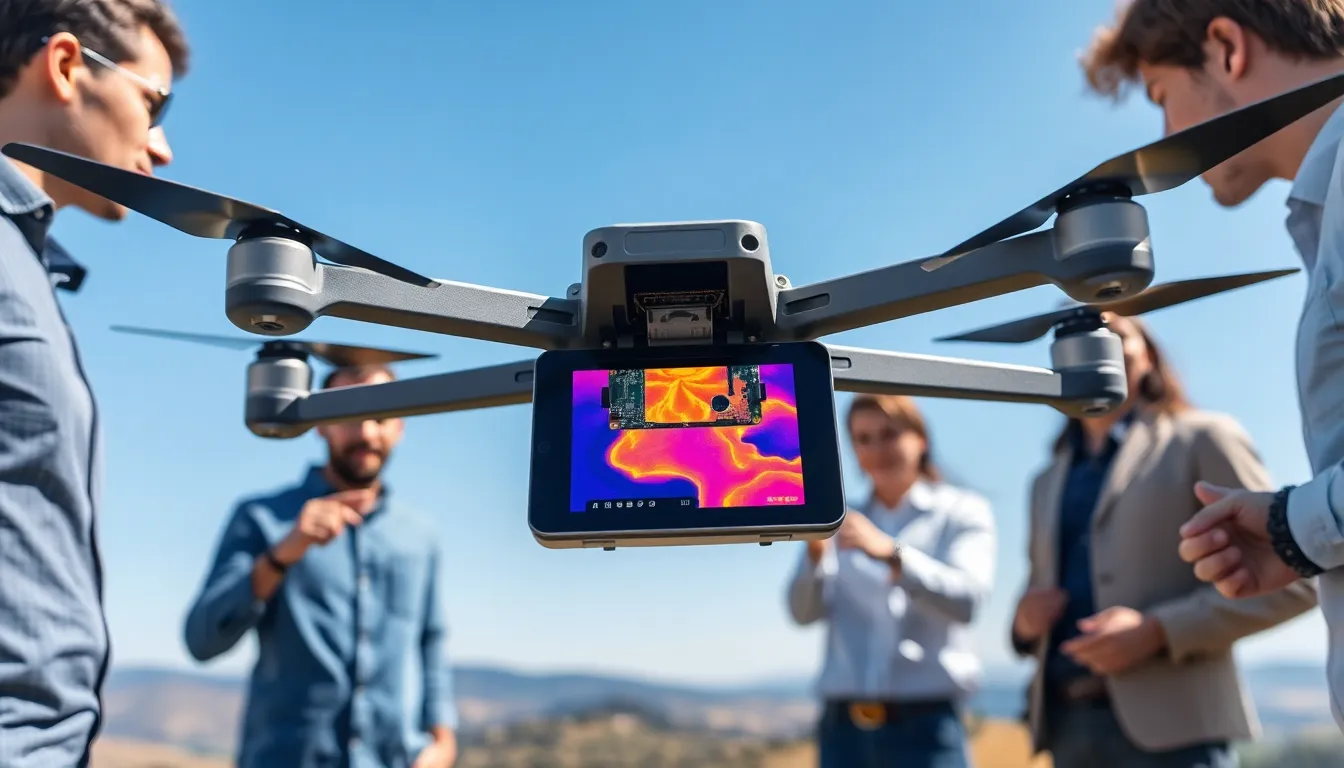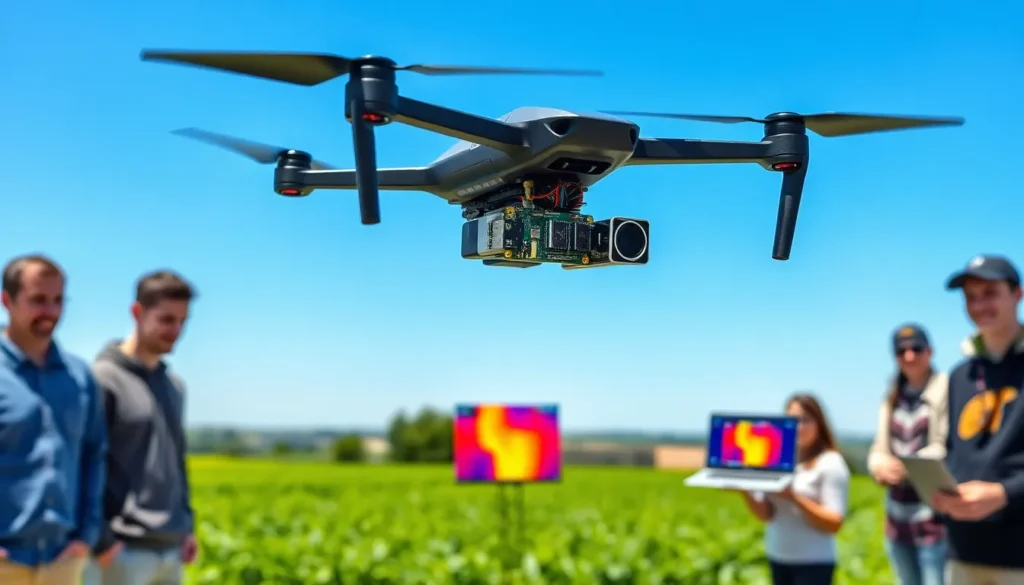Table of Contents
ToggleEver thought about soaring in the skies with a drone that doesn’t just fly but also sees heat? Welcome to the world of Raspberry Pi Zero thermal drones, where innovation meets affordability. With the Raspberry Pi Zero, DIY enthusiasts can create their very own thermal imaging drone without burning a hole in their wallets. Ready to embark on an electrifying journey into aerial technology? Let’s jump into the nuances, humor, and surprisingly fascinating details of this tech marvel.
Overview of Raspberry Pi Zero and Its Applications

The Raspberry Pi Zero is an astonishingly small, cost-effective single-board computer that has earned its stripes in various applications. Initially designed as a low-cost introduction to computing, it has transcended its original purpose, finding its way into projects ranging from home automation to robotics. It’s particularly attractive for DIY enthusiasts because of its compact size and flexibility.
In the realm of drones, the Pi Zero is a game changer. It’s lightweight, making it the perfect fit for flying machines where every gram counts. Whether it’s for educational purposes, agricultural monitoring, or even fun weekend photography, the Raspberry Pi Zero offers endless applications. Who wouldn’t want to harness such a versatile tool for groundbreaking creations? Hence, it’s no wonder that tech enthusiasts are increasingly exploring this option for forming their thermal drones.
Understanding Thermal Imaging in Drones
Thermal imaging is the ability to capture and analyze the infrared radiation emitted by objects, essentially allowing one to see heat. When coupled with drones, this technology opens the door to diverse possibilities. Imagine searching for lost pets or detecting electrical faults in buildings, all without having to land. Sounds amazing, right?
In a nutshell, drones equipped with thermal cameras can identify temperature differences, making them invaluable in fields like firefighting, search and rescue, and agriculture. For instance, farmers can monitor crop health and manage water resources effectively. Also, in emergencies, responders can locate individuals quickly, even through thick foliage or debris. Thermal imaging drones are indeed reshaping how we approach various challenges in our lives.
Building Your Raspberry Pi Zero Thermal Drone
Key Components Needed for Your Thermal Drone
Starting your DIY Raspberry Pi Zero thermal drone project means gathering some essential components. You’ll need:
- Raspberry Pi Zero: The core of your drone, acting as the brain.
- Thermal Camera Module: A camera that converts thermal energy into visible images. The FLIR One or similar can be an excellent choice.
- Drone Frame: Choose a lightweight yet sturdy frame to house all the components. You can find off-the-shelf options or 3D-print your unique design.
- Flight Controller: This component will control the drone’s flight. Make sure it’s compatible with the Pi.
- Battery and Propellers: Essential for flight, select a battery with sufficient power and propellers that fit your frame size.
Once you have these components, you’re one step closer to your aerial adventure.
Software and Configuration for Thermal Imaging
Now that you’ve assembled your hardware, it’s time to tackle the software. You’ll need to install the Raspbian OS on your Raspberry Pi Zero. Afterward, configure it to work seamlessly with your thermal camera. Popular libraries like OpenCV can help manage the thermal imaging data effectively. Making sure everything communicates properly will save you headaches later. Don’t forget to test parameters like altitude and temperature settings according to your project needs. By optimizing both hardware and software, you can maximize the performance of your thermal drone.
Flying and Testing Your Drone
Once your Raspberry Pi Zero thermal drone is built, it’s time to take to the skies. But hold your horses, before launching, ensure you’ve conducted several ground tests. Check that all components are functioning correctly. During the flight, keep an eye on the thermal images as they can give you instant feedback on how your drone performs in real conditions.
Make sure to fly in open spaces at first: think grassy fields rather than crowded city parks. It’s crucial to have a safe testing ground where you can easily monitor battery levels, control responsiveness, and thermal camera accuracy. After a successful maiden flight, try experimenting with different altitudes and imaging angles. The beauty of DIY drones lies in the ability to test and customize, learning as you go along.
Challenges and Solutions in Thermal Drone Operation
Like any project, building a thermal drone with a Raspberry Pi Zero comes with its own set of challenges. First up is thermal camera calibration. Inaccurate calibration can lead to misleading thermal data, boiling down to potential risk in critical implementations like search and rescue operations. Regular checks can help maintain accuracy.
Another challenge relates to power consumption. The Raspberry Pi Zero and camera can quickly drain batteries, especially if the drone operates for long durations. Consider upgrading your battery capacity or optimizing power management settings in the Raspberry Pi. Ensuring components are lightweight helps too. Finally, be prepared for weather conditions: strong winds can affect flight stability. Adapting to these challenges ensures your drone remains resilient in diverse situations.
Future Trends in Thermal Imaging Drones
The future of thermal imaging drones is bright and promising. As technology continues to evolve, one can expect advancements in camera resolution, processing speeds, and even AI integrations. Picture drones that can autonomously assess situations and deliver real-time data to ground teams.
Also, sectors like agriculture, emergency response, and environmental monitoring may soon see drones equipped with multi-spectral cameras and advanced analytics capabilities. Innovations in battery technology will also likely enhance the flight time, paving the way for extensive aerial inspections or surveys. As laws and regulations evolve, the seamless integration of thermal drones into everyday application will undoubtedly reshape industries globally. Being at the forefront of this change can open up new avenues for enthusiasts and professionals alike.




